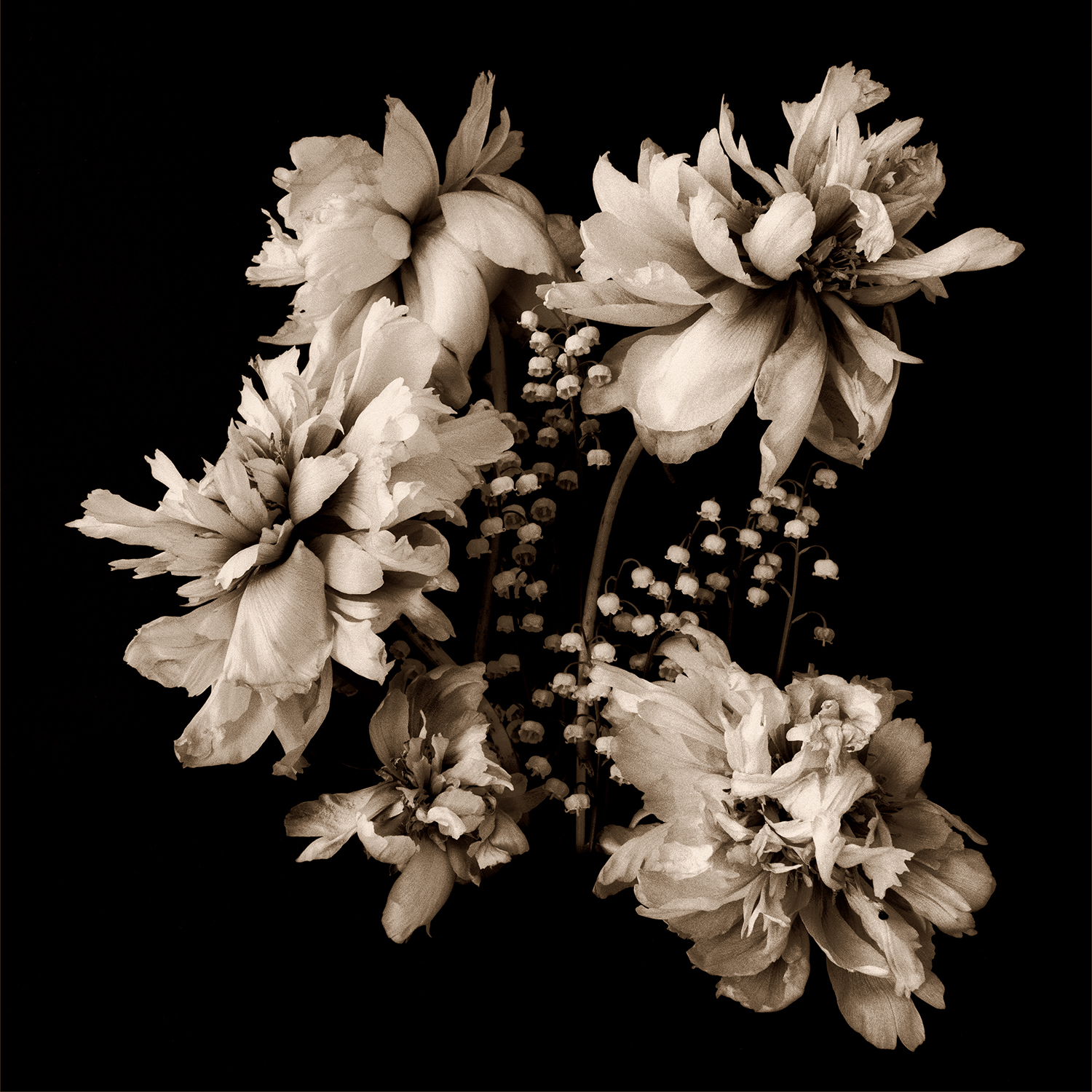Botanica
April 29- May 31
Artists' Reception May 2, 5-7PM
Dedee Shattuck Gallery is pleased to present Botanica, a group exhibition exploring flora in a variety of mediums, complimentary to the galleries emphasis on the relationship between contemporary art and the environment. The exhibit runs April 29th through May 31st, with an artists’ reception on Saturday, May 2nd from 5-7pm.
Jessica Calderwood
Jessica Calderwood's most recent series combines flower/botanical forms with fragments of the human body in order to address the narrative of human life cycles: growth, metamorphosis, aging, death. The choice to use flower and plant forms is multi-layered. Flowers have been used throughout history as symbols of the feminine: ‘she is as delicate as a flower', it can be found in mythology, literature, folklore and visual art. Western culture has an intricate system of flower symbolism that has been a way for humans to express and communicate complex emotions. Calderwood is interested in using these symbolic references in order to talk about issues of gender and identity.
Calderwood created these work to be intentionally humorous and ironic. These human/plant hybrids are large, voluptuous, headless, and armless. The flower forms become a negation, a censoring or denial of what lies beneath. These anthropomorphic beings are at once, powerful and powerless, beautiful and absurd, inflated, and amputated.
Jessica Calderwood is an image-maker and sculptor that works in esoteric craft media. She uses a combination of traditional and industrial metalworking processes as a means to make statements about contemporary life. Her works are imbued with personal stories and vibrant color. She received her BFA from the Cleveland Institute of Art and her MFA from Arizona State University, with an emphasis in Metalworking. Her work has been exhibited throughout the U.S. and internationally in curated and juried exhibitions. She has participated in artist residencies with the John Michael Kohler Arts/Industry Program, Ferro Corporation, and the Mesa Arts Center. Her work has also been published in Metalsmith Magazine, American Craft, NICHE, Ornament, the Lark 500 series, and the Art of Enameling. She is currently an Associate Professor of Art at the University of Wisconsin-Oshkosh.
Georgia Marsh
Flower painting has a truly millennial presence throughout the histories of art. The ubiquity of floral depictions across the long arc of tradition in all cultures tells us that something about them is important to human experience. Marsh believes it to be the uncanniness of plants: a meaningless, godless, radical beauty, whose significance is only manifested through the arrangements we make of them, by being embedded within and framed by form.
Georgia Marsh lives and works in New York, NY and Jamestown, RI.
Anna Kristina Goransson
Anna Kristina Goransson's work in Botanica is inspired by investigating seeds and new growth. Thinking about the possible outcomes, what might grow from these giant seedlings once they fully release from their pods, Goransson made these works in winter while dreaming of the spring that she hoped would soon arrive. She tried to capture the true magic and mystery of what happens as the snow melts away and the world starts to regain its color and new beginnings are budding all around.
Goransson works in white wool to create forms that she then dyes, getting energetic colors that she hope gives a sense of the forms being full with life. The wool, ideal for creating seamless forms that are soft yet structural and have a bit of the otherworldly to them, inspires her immensely as she works and explores the possibilities of this versatile material. As she ponders the growth of her work, she can’t help thinking of the many plants and flowers that each year make the impossible seeming burst to life from seed to full grown beauty.
Anna Kristina Goransson’s Swedish background has greatly influenced her life with a love for art and design as well as nature. This initial spark led her to study furniture at RISD and fibers at UMass Dartmouth. She was introduced to felt making while studying for her master’s degree and has continued to work with wool and dyeing in various ways since. Goransson finds inspiration in the intricacies of nature, the patterns created by the environment, and in the act of making. She continues exploring through her studio work while also teaching fibers techniques around New England.
Beth Galston
Luminous Garden (Wave) is the latest in an ongoing series of Luminous Garden installations that explore relationships between the natural and the manmade. These immersive environments are created by colored LEDs embedded in translucent resin forms cast from seedpods. The little lights could be thought of as a life force/energy system of the plants, while the masses of wires that provide the electrical power suggest plant root systems. Galston has been using the medium of light combined with the idea of a garden to create places of growth, transformation, and enchantment.
In this new work, blue LED lights are controlled by a computer to create a glowing wave of movement that evolves and repeats over time. This slow repeating wave seems to synchronize with one's breath, and evokes natural cycles such as tides and seasons. Although the means are technological, ultimately the imagery is about nature and the experience of being immersed in it.
Beth Galston is a sculptor and environmental artist who creates site-specific installations using light and various materials to transform spaces and engage viewers as participants. She lives in Carlisle, MA and maintains her studio in Somerville MA, and is active as both a studio and public artist. Galston received a M.S. from MIT's Center for Advanced Visual Studies, where she was also a Fellow for five years. Galston’s sculptures are currently featured in the yearlong exhibition “Branching Out: Trees as Art” at the Peabody Essex Museum. In the studio, she continues her exploration of the “Luminous Garden” series, immersive environments made of LEDs, cast resin forms, and wire.
Yoonmi Nam
Yoonmi Nam's work considers the space where transience and permanence coexist. In her on-going drawings and prints, she uses images of man-made environments and cut flower arrangements as metaphors to evoke a sense of time that is both fleeting and eternal. Nam is interested in beauty, irony, impermanence, and the common and extraordinary way we structure our surroundings.
In the arranged flower imagery, the flowers, once cut from their roots, have only a short remaining time to live. They will quickly wither and die, but before they do, they are elegantly and elaborately arranged, as if time will stand still for them.
Yoonmi Nam was born and raised in Seoul, South Korea, spending part of her youth in Canada. She received a B.F.A. degree in Printmaking from Hongik University in Seoul, Korea. She moved to America to study at the Rhode Island School of Design, where she received a M.F.A. degree in Painting and Printmaking in 2000. Her work considers the cross-cultural experience and sense of transience through prints, installations and drawings. Nam uses images of man-made environments and the culture of cut flower arrangements as metaphors to evoke a sense of time that is both fleeting and eternal. Currently, she is an Associate Professor in the Department of Visual Art at the University of Kansas.
Reenie Barrow
Renee Barrow's images reflect her interest in photographing flowers as metaphors. Barrow's goal is to make her photographs visually compelling as well as serving as catalysts for the viewer to contemplate words, sensations, or memories. She allows each flower to tell its story by using a simple background and relying on the balance, symmetry, and interaction between the flowers to create its tale. Barrow uses Latin words to create a title for each of the stories unfolding behind the glass.
Reenie Barrow’s photographs represent her long-standing interest in documenting the details of daily life around the world. Her career has taken her to a variety of countries, most notably Vietnam, Greece, Sweden, France, Mexico, Cuba, Spain and several Caribbean islands.
In the past 25 years, Barrow has displayed her work in more than 100 U.S. and international exhibits, including shows at the Association of International Photography Dealers, New York, Art Institute of Chicago, the International Center of Photography in New York City, the Cuban Center for Photography, Havana, Cuba, and the Zappion National Gallery in Athens, Greece. In addition, numerous private and corporate collections (among them Reader’s Digest, IBM, Fidelity Investments, Connecticut Bank and Trust and the Art Institute of Chicago) permanently house Barrow’s photographs.
Her five years of travel to Greek mountain villages culminated in 1992 with the publication of her book, Wreath of Dreams: Visions of Greek Villags (Kastaniotis Editions). Her photographs have been included in Gardner’s Art Through the Ages (Harcourt Brace, 1996), which showcased two of her photographs of Greek relics, featured in the Feb. 06 issue of Architectural Digest, and Hearst Publication’s Country Living.
Recently, Barrow’s interest in film led to her involvement as a stills photographer for several movie and television projects, one of which was a recently completed Sundance Institute-funded film, Stay Until Tomorrow. She is currently working on a film starring Blythe Danner, The Second Wind.
Among the honors Barrow has received is a 1990 award from the Greek government recognizing exceptional contributions of Hellenic culture, and an individual artist’s grant from the Connecticut Commission on the Arts. A graduate of the University of California, Berkeley, Barrow resides in Bristol, Rhode Island.
Leslie Ferst
Leslie Ferst explores the interplay between reality, illusion and memory to create organic natural spaces for one to inhabit. Within the installation “Moving Toward Light” are independent and interdependent forms that are abstractions reminiscent of botanical shapes, rhythms, patterns and details from fragile ecosystems she has known and observed. Each form individually stands alone but together the group is a dynamic, evocative and imaginative world that calls attention to our ambiguous, delicate and primal relationship with nature.
Born in Atlanta, Leslie Ferst majored in Art History at Skidmore College. Formative undergraduate studies took her to Italy, Greece and the Netherlands. After apprenticing with Charles Counts in Georgia and Regis Brodie back at Skidmore, Ferst continued her studies with Chris Gustin and Rick Hirsch at Boston University where she received her MFA in Ceramics in 1984. Among her Artists Residencies were Ossabaw Island at the Ossabaw Island Foundation (Georgia), the Archie Bray Foundation (Montana) and the Watershed Center for the Ceramic Arts (Maine) where she became a founding board member. From 1993-2012 Ferst was Visiting Assistant Professor in the Art Department at Skidmore where she taught all levels of ceramics. She has taught at University of Vermont, Boston University, Johnson State College, and in the “SUMMER SIX”, now “Summer Art” Program at Skidmore.
Among her over 100 national exhibitions are “Natural Wonders” at the LaCoste Gallery/MA, a solo show “Full Circle” at the Signature Shop and Gallery/Atlanta, “Craft Transformed” at the Fuller Museum/MA, “Ancient Practice: New Vision” at the Munson Williams Proctor Institute/NY, and “The Yixing Effect: Echoes of the Chinese Scholar” at the Holter Museum of Art, Helena Montana. Leslie’s sculpture traveled nationally in the NCECA (National Council for Education in the Ceramic Arts) Clay National (2003,1997). She is currently represented by Graficas Gallery Nantucket Massachusetts. Collections include the Frederick Weisman Museum of Art, the Mori Museum/Hakodate Japan, the Archie Bray Foundation, Georgia Institute of Technology, Georgia Council for the Arts, Siena College, and Skidmore College.
Dedeeshattuckgallery.com | 508. 636. 4177 | 1 Partners' Lane, Westport, MA 02790 | W - Sat, 10 - 5, Sun 12 - 5





























